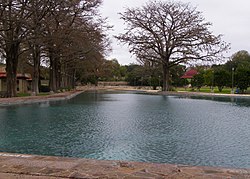San Pedro Springs Park
San Pedro Springs Park | |
 San Pedro Springs Park | |
| Location | 1415 San Pedro Avenue San Antonio, Texas |
|---|---|
| Coordinates | 29°26′49″N 98°30′06″W / 29.44694°N 98.50167°W |
| NRHP reference No. | 79002916[1] |
| RTHL No. | 3806 |
| Significant dates | |
| Added to NRHP | November 1, 1979 |
| Designated RTHL | 1965 |
San Pedro Springs Park is located in the Bexar County city of San Antonio in the U.S. state of Texas. Surrounding the source of the springs, the 46-acre park is the oldest in the state of Texas. It is the location of a Payaya Indian village known as Yanaguana,[2] and is the original site of the city of San Antonio.[2] The park is alternately known as San Pedro Park. The park was designated a Recorded Texas Historic Landmark in 1965.[3] It was added to the National Register of Historic Places listings in Bexar County, Texas on November 1, 1979.[2]
Although it is often stated that it is the second oldest city park in the United States after Boston Common, it is at most the tenth oldest after Plaza de la Constitución in San Augustine, Florida among others.[4]
History, first European contact, founding of San Antonio
Archaeological findings have uncovered evidence that human presence in the area dates back 12,000 years.
The park
Based on the original Spanish land grant, the city of San Antonio's first surveyor
Swiss landscape designer John J. Duerler leased land adjacent to the park, and reached an 1864 agreement with the city to redesign the park. Duerler developed the park with landscaping, a garden, picnic areas, a zoo and aviary, a music pavilion, and even a racetrack.[10] Naturalist Gustave Jermy opened the Museum of Natural History in the park in 1885. The park suffered in 1891 when wells dug into the Edwards Aquifer dwindled the park's water supply. Between 1897 and 1899, the park was renovated under the direction of Mayor Bryan Callaghan. Beginning just before World War II, the water needs of a burgeoning population once again decreased water levels, drying up the springs for the next 35 years. When excessive rainfalls during the 1990s replenished the park's water supply, the public once again became interested in the park.[7][9] The park underwent an additional renovation 1998-2000.[11]
Park facilities include a gazebo, swimming pool, restrooms, softball and tennis areas, a playground, a skate plaza, the San Pedro Library, and the San Pedro Playhouse [12]
Gallery
-
1907 Postcard, San Pedro Springs Park and Lake
See also
References
- ^ "National Register Information System". National Register of Historic Places. National Park Service. April 15, 2008.
- ^ a b c d e f "NRHP-THC San Pedro Springs Park". Texas Historical Commission. Retrieved September 28, 2012.
- ^ "RTHL-THC San Pedro Park". Texas Historical Commission. Retrieved September 28, 2012.
- ^ Fisher, Lewis F. (June 3, 2017). "San Antonians' Eight Favorite Myths". San Antonio Express-News. Retrieved October 23, 2023.
- ^ a b c d e "The Oldest Park in Texas". Texas Highways. Retrieved September 28, 2012.
- ISBN 978-0-8078-5580-5.
- ^ a b c "San Pedro Springs". Edwards Aquifer. Retrieved September 28, 2012.
- ^ Stover R.L.A., Scott E. "San Pedro Springs Park, Texas" (PDF). Design (Winter 1996). U. S. Department of the Interior: 6, 7. Retrieved November 2, 2012.
- ^ ISBN 978-0-7627-4787-0.
- ISBN 978-1-4685-0552-8.
- ^ Kendall, Dorothy Steinbomer. "San Pedto Park". Handbook of Texas Online. Texas State Historical Association. Retrieved September 28, 2012.
- ^ "San Pedro Springs park". Parks and Recreation. City of San Antonio. Retrieved September 28, 2012.



